A Case Study of Natya: Theatre Arts Journal Published by the Bharatiya Natya Sangh in 1950s-60s
01
Covers of the three issues (1958-1961) of Natya in the Anand Gupt Collection at the Alkazi Theatre Archive
When one attempts to analyse the relationship between print culture and theatre, it becomes essential to interrogate the process, as well as the apparatus involved in the production of printed materials focusing on theatre. Who were the producers? What were their objectives? How does the position of the producers within a particular network influence circulation and readership?
Historicizing theatre print culture and its producers – organizations, institutions, editors, management – within the wider networks of not just theatre circuits, but also within the networks of the cultural landscape of a society, helps one gain ethnographic information of a particular time, thus evaluating the social function of theatre in it. The position of the producers in the cultural as well as socio-political sphere becomes increasingly crucial to understand the ideological underpinnings of particular printed materials and the ways in which they have helped shape the theatre movement in India.
While the dust from the Second World War was settling down, Rosamond Gilder, Executive Member of the International Theatre Institute (set up in 1947), voiced the institute’s views and objectives on the employment of theatre to bring about ‘international understanding’. In the Autumn 1958 issue of Natya (an international theatre journal, published from New Delhi), Gilder wrote, “There has never been a time in world history where it was so important for the people of the world to understand each other; to recognize each other’s likenesses, to accept each other’s differences, to appreciate and value the finest elements in each other’s way of living, thinking and expression. One of the most effective means by which we can acquire this much needed knowledge is the theatre…Drama is a “thing done” and it is this quality of action that has made it, since the beginning of history, one of the most powerful and certainly the most popular means of expression through which man has sought to understand himself, his fate, his gods, his relation to the universe”. India became a part of this international effort led by International Theatre Institute UNESCO with Bharatiya Natya Sangh (BNS), which was established by Kamaladevi Chattopadhyay in Delhi in 1949.
The earliest journal in the Anand Gupt Collection at the Alkazi Theatre Archive, is a quarterly titled: Natya – Theatre Arts Journal, produced by the Bharatiya Natya Sangh, New Delhi from 1956. From the 1950s, the Bharatiya Natya Sangh collaborated with many theatre groups and cultural institutions like Padatik, Ford Foundation, ICCR, Asian Cultural Council and Zonal Cultural Centres of the Sangeet Natak Akademi to conduct workshops, festivals, conferences and seminars. Through its initiatives, collaborations and representations, the Bharatiya Natya Sangh was making an attempt to articulate ‘Indian’ identity on the international theatre scene. The Sangh hosted the ‘First World Conference of International Theatre Institute’ in Bombay from October 29 to November 2, 1956 on the theme of ‘popular theatre’. Similarly, BNS conducted the East-West Theatre Seminar on “Total Theatre” (October 24-30, 1966) in Delhi, International Workshop on Kathakali and Chhau Mask Dance Tradition (1978) in Delhi, Mylapore Festival (Tamil Nadu), New Playwrights Festival (Pune) in 1987-88, Dramatic competitions in Bombay, Patna and Allahabad from 1968 to 1975, and was the co-sponsor of the Sangeet Natak Akademi’s 1956 Drama Seminar. It was around the same period that the Indian cultural scene was grappling with the idea of ‘modern’ India and its representation through a ‘national’ theatre, which was initiated through the setting up of cultural institutions like Sangeet Natak Akademi and National School of Drama, eventually paved way to the emergence of the ‘theatre of roots’ movement during the seventies, led by directors and playwrights like K. N. Panniker, Girish Karnad and H. Kanhailal. Situated in such early years of nation building are the three special issues of the Natya journal (from 1958-1961) dedicated to theatre architecture, international theatre and Tagore centenary celebrations, edited by Som Benegal.

The 1958 Autumn International Number, with a dramatic cover illustration in bright yellow and black ink signed by the artist ‘PAMMI’, carried news on theatres from Australia, England, France, Bulgaria, Czechoslovakia, China, Turkey, Greece, Germany, Sweden, Finland, Denmark, America, South-East Asia, India, Mongolia, Tibet, Switzerland, Hungary, Poland, Soviet Russia, Yugoslavia and Romania. The authors in this issue hailed from different parts of the world, including Rosamond Gilder (theatre critic and member of the Executive of the International Theatre Institute), J. C. Trewin (British journalist, writer and drama critic), Maurice Kurtz (writer and playwright), Mitso Andonov (on Bulgarian Theatre), Kamaladevi Chattopadhyay, Richard L. Coe (theatre and cinema critic).
Along with articles on Mongolian Theatre, Hungarian Theatre, Theatre in Finland, Lama Dances from Tibet, etc. the issue also carries photo features on ‘The Greats of the American Stage’ and ‘Indian Amateur Drama’. ‘The Greats of the American Stage’ photo feature include photographs of Edwin Forrest in Robert Montgomery Bird’s The Gladiator, Edwin Booth as Hamlet, Katharine Cornell as Antigone directed by Lewis Galantiere, Helen Hayes in Victoria Regina, Julia Harris in The Lark by Jean Anouilh, a group photo of Lionel Barrymore, Ethel Barrymore and John Barrymore, Lynn Fontanne and Alfred Lunt in The Pirate, Maurice Evans, and Orson Welles in Macbeth. The Indian amateur drama is represented through the figures of Pheroza Cooper, Hilla Cooper and Bomi Kapadia in Moliere’s The Miser directed by Theatre Unit’s Ebrahim Alkazi. Photographs of Manohar Pitale in St. Joan (directed by P. D. Shenoy) and Hima Devi, Derek Bond, Hilla Cooper in 1958 production of Hedda Gabler (directed by E. Alkazi) is part of the photo feature. Another interesting article in the journal highlights the new trends and influences on contemporary Chinese drama with a photograph of the production of Chu Yuan by Kuo Mo-jo.
Article on Chinese Drama Today in Natya-1958‘Chinese Drama Today’ by Tien Han in Natya, Autumn International Number, 1958
03
Photo Feature on ‘The Greats of the American Stage’ in Natya, Autumn International Number, 1958
04
Photo Feature on ‘Indian Amateur Drama’ in Natya, Autumn International Number, 1958
The editorial penned by Som Benegal can be interpreted to understand how the popularity of theatre magazines and journals was directly proportional to the interest in theatre as a form and vice versa despite the popularity of cinema in the 1950s. Benegal writes, “The happiest feature of this widespread interest is the fact that theatre in India has survived the onslaughts of the film…The Indian film industry is among the biggest in the world, yet save in a handful of instances, it has failed to escape from escapism and, despite vast resources poured into it, is lacking in any intellectual content…This may be the seed of survival for drama…The live theatre, it appears, is bound to appeal because in an area of comparative freedom it can meet an intellectual demand in an atmosphere of unique communication denied in the two-dimensional impersonal film…In view of this national interest in theatre, the conception of this International Number grew” (p. 31).
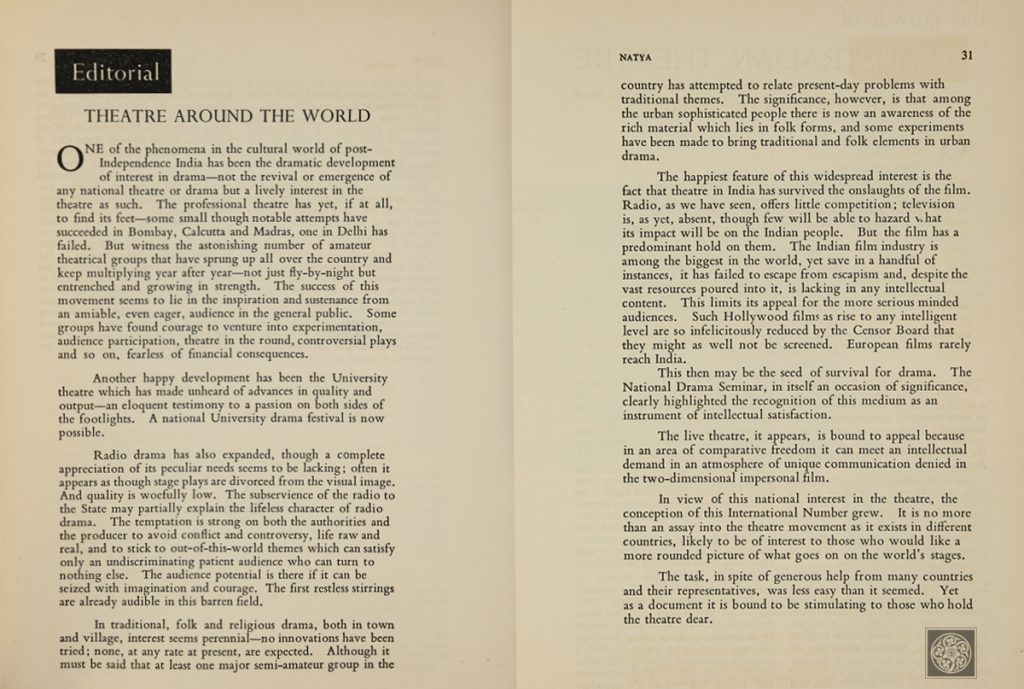
The 1958 issue of Natya contains approximately a hundred advertisements ranging from companies like Johnston Pumps Pvt. Ltd. to Ashoka Hotel, Chanakyapuri, New Delhi to the Government of Bombay advertising the second Five Year Plan. Most of the narratives of these advertisements point towards the making of a new nation and in turn of a public culture. The analysis of advertisements, use of different colors in print, the quality of the paper and the design of the magazine as a whole makes an excellent example of how magazines run by influential institutions and people and circulated internationally, received ample advertisements from across the spectrum as compared to the regional magazines and journals produced by amateur theatre-makers in regional languages with limited circulation and reach.

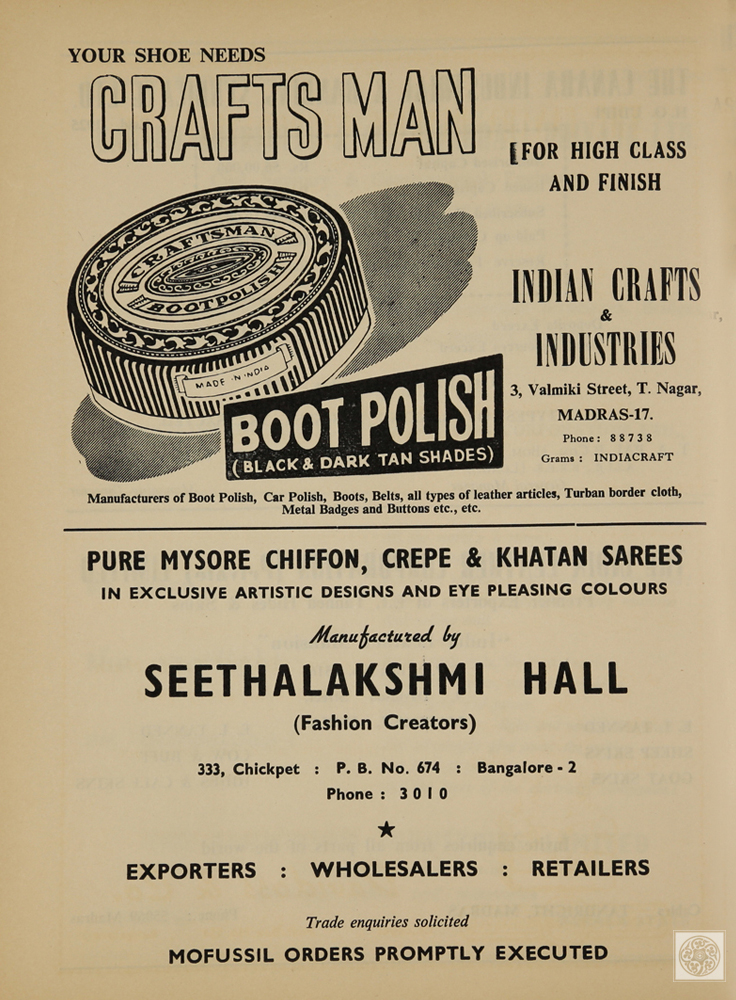

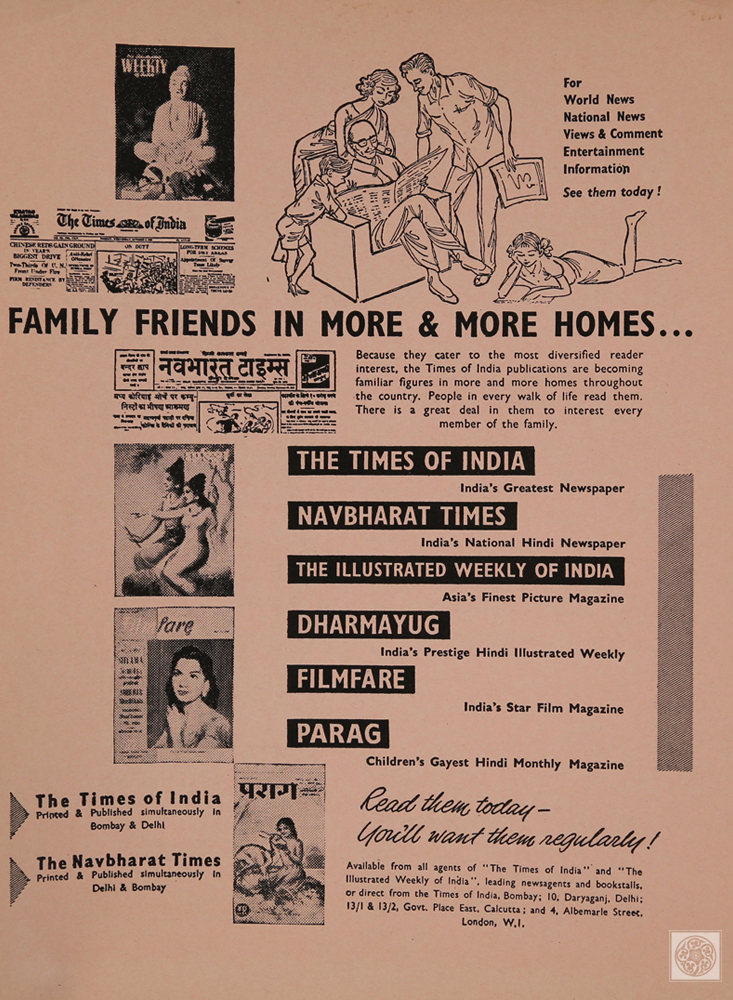
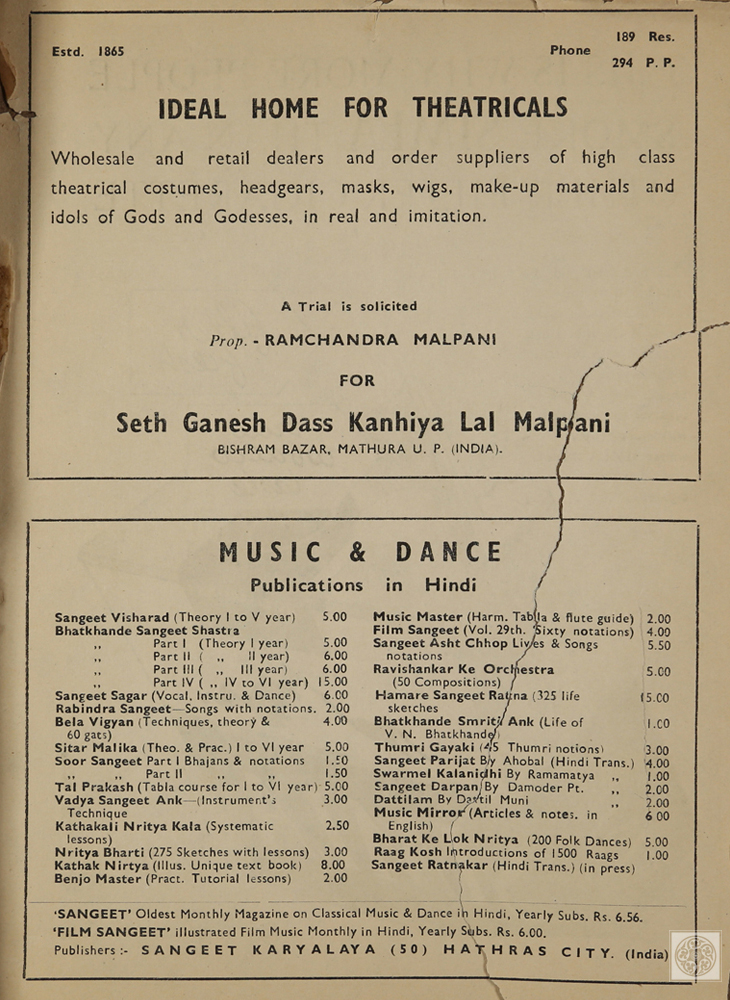

Bringing together different aspects of theatres from the world in a compact, couple of hundred paged journal, priced at Rs. 3/- per issue and a yearly subscription at Rs. 8/-, Natya and its producers facilitated international dialogue and exchange of theatre, its form, functions, genre as well as approaches to spaces. In an attempt to situate India and its theatre within the nexus of a global theatre culture, Natya advertised itself through subscription letters as the only journal in India to offer ‘exclusive and comprehensive coverage on the big events in drama not only in this country but all over the world’. Catering to a variety of readers, the subscription ad reads, ‘serious articles for serious, popular articles for light reading, technical articles for theatre workers’ and makes publication of full length scripts of ‘actable plays’ as one of its features. Such journals not only inform a theatre historian about the trends and movements in theatre of a particular time, but also provide primary sources on the changes in management of institutions. For instance, Som Benegal announces the retirement of Kamaladevi Chattopadhyay in the editorial of the Theatre Architecture number (Winter, 1959-60). On the next page, below an illustration of a building structure in black and orange, the new president of the Sangh is introduced – Bharatidevi Sarabhai.
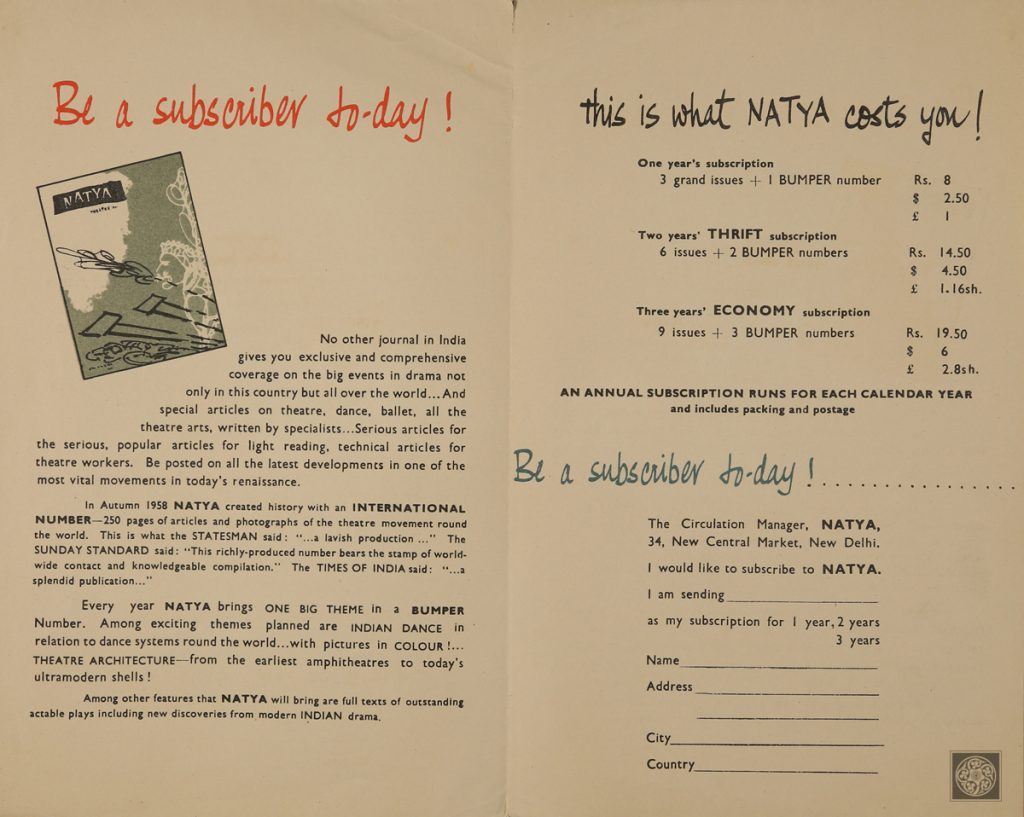

Introducing the Winter 1959-60 issue of Natya titled the ‘Theatre Architecture Number’, Benegal highlights the debates on theatre architecture in 1940s-50s India, questioning the correlations between form and function and whether to adopt western or traditional approach or combine both. Welcoming the Central Government’s move to build a National Theatre and grant subsidies to state governments to build urban and rural theatres on the occasion of Tagore Centenary, Benegal underlines the efforts taken by Bharatiya Natya Sangh to ‘stimulate thinking on theatre construction and to help architects in positive ways’. It was out of these efforts that a special number on ‘Theatre Architecture’ was published. Apart from the publication of the special number, Benegal also mentions that the Sangh had decided to organise an international exhibition of theatre architecture and a symposium on ‘different aspects of drama and the relationship between the needs of the theatre as an art and as a building’. An illustrated article by Walter Unruh showcasing the new developments in stage design and equipment, highlights the varied perspectives that the journal was attempting to bring to Indian theatre-makers. Through evidence like these, it becomes clear how the print culture was contributing to theatre thinking as well as theatre-making in the public sphere.
On Building Theatre
Editorial and Content Page by Som Benegal in Natya, Winter Theatre Architecture Number, 1959-60
11
‘New Developments in Theatre Building and Technical Stage Equipments’ by Walther Unruh in Natya, Winter Theatre Architecture Number, 1959-60
